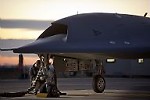The Neuron makes its first flight

(BRUSSELS2) It was in Istres today (December 1) in the south of France. Alone (or almost), the Neuron made its first flight. This stealth combat drone demonstrator is indeed piloted on the ground. It was the Dassault Aviation teams, who held the control, under the watchful eye of the technical experts of the DGA who ensured control of the airspace (so that nothing could spoil or delay this flight). Started in 2003, notified in 2006, this program should prepare the ground for a combat drone or future fighter plane by 2030.
The test campaign begins
This flight is a major step ” is estimated at the DGA because this paves the way for flight test campaigns of the demonstrator in Italy, Sweden and France. The purpose of these tests is to demonstrate the flight qualities of the platform, but also to assess its stealth and combat capabilities. The drone must, in fact, be capable of carrying out an air-to-ground mission, based on the detection, localization and recognition of targets on the ground, autonomously, that is to say by correcting its position if necessary ; then to carry out a shot from an internal bay, within very short response times. The demonstrator also makes it possible to assess the detectability of a stealth platform in the face of ground and air threats, both in the field of the radar signature and in that of the infrared signature. 9 m long, with a wingspan of 12 m, with a total weight of 7 tons, the Neuron can reach a maximum speed of 980 km / hour close to Mach 1 (1220 km / h).
European program
Started in 2003, the Neuron is a program carried out in European cooperation, with 5 other countries (Italy, Sweden, Spain, Greece, Switzerland) but under strong French impetus. The DGA manages the project and is the sole executing agency. While Dassault Aviation, as sole prime contractor, is responsible for the execution of the main contract. " The objective of this project is not to create new technological capacities in Europe, but to make the most of existing niches” is estimated at Dassault.
Breakdown of tasks
The French manufacturer is responsible for the overall design and architecture of the system, flight controls, stealth devices, final assembly, system integration, as well as ground and flight testing. The Italian Alenia Aermacchi is contributing to the project with an innovative concept of an internal weapons bay (known as the "Smart Integrated Weapon Bay" - SIWB), an internal EO/IR sensor, the bay doors and their opening mechanism, as well as the platform's electrical system, and anemometry. The Swedish SAAB is in charge of the design of the main fuselage, landing gear doors, avionics, as well as the fuel system. Euro-Spanish (EADS-CASA) brings its experience for the wings, the ground segment, and the integration of the data link. The Greek Hellenic Aerospace Industry (HAI) is responsible for the rear section of the fuselage, the nozzle, as well as the supply of racks for the “global integration bench”. While the Swiss RUAG takes charge of the low-speed wind tunnel tests, and the interfaces between the platform and the armaments. Note that there is no British in this project, BAE Systems is indeed developing a competing system, the Taranis.


Comments closed.